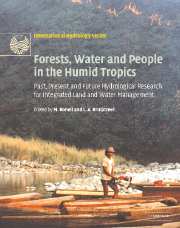 Forests, Water and People in the Humid Tropics
Forests, Water and People in the Humid Tropics Book contents
- Frontmatter
- Contents
- List of contributors
- Foreword
- Preface
- Acknowledgements
- Symposium and Workshop
- Introduction
- Part I Current trends and perspectives on people–land use–water issues
- Part II Hydrological processes in undisturbed forests
- Part III Forest disturbance, conversion and recovery
- 19 Natural disturbances and the hydrology of humid tropical forests
- 20 Spatially significant effects of selective tropical forestry on water, nutrient and sediment flows: a modelling-supported review
- 21 Effects of shifting cultivation and forest fire
- 22 Soil and water impacts during forest conversion and stabilisation to new land use
- 23 Large-scale hydrological impacts of tropical forest conversion
- 24 Forest recovery in the humid tropics: changes in vegetation structure, nutrient pools and the hydrological cycle
- 25 The hydrological and soil impacts of forestation in the tropics
- 26 The potential of agroforestry for sustainable land and water management
- Part IV New methods for evaluating effects of land-use change
- Part V Critical appraisals of best management practices
- Conclusion: Forests, water and people in the humid tropics: an emerging view
- Plate section
- References
26 - The potential of agroforestry for sustainable land and water management
from Part III - Forest disturbance, conversion and recovery
Published online by Cambridge University Press: 12 January 2010
- Frontmatter
- Contents
- List of contributors
- Foreword
- Preface
- Acknowledgements
- Symposium and Workshop
- Introduction
- Part I Current trends and perspectives on people–land use–water issues
- Part II Hydrological processes in undisturbed forests
- Part III Forest disturbance, conversion and recovery
- 19 Natural disturbances and the hydrology of humid tropical forests
- 20 Spatially significant effects of selective tropical forestry on water, nutrient and sediment flows: a modelling-supported review
- 21 Effects of shifting cultivation and forest fire
- 22 Soil and water impacts during forest conversion and stabilisation to new land use
- 23 Large-scale hydrological impacts of tropical forest conversion
- 24 Forest recovery in the humid tropics: changes in vegetation structure, nutrient pools and the hydrological cycle
- 25 The hydrological and soil impacts of forestation in the tropics
- 26 The potential of agroforestry for sustainable land and water management
- Part IV New methods for evaluating effects of land-use change
- Part V Critical appraisals of best management practices
- Conclusion: Forests, water and people in the humid tropics: an emerging view
- Plate section
- References
Summary
INTRODUCTION
Improving the efficiency of land and water resource use
Much of the future increase in food and wood production in the humid tropics (and elsewhere), necessary to meet the needs of increasing populations and to reduce hunger and poverty, will have to be achieved from land and water resources already in use. Field observation shows that the extent of the ‘land balance’ – land that could be used for productive purposes but is not currently in use – is very limited. Estimates by FAO and associated organisations appear to show substantial areas which are cultivable but not presently cultivated (Alexandratos, 1995; Bot et al., 2000). However, the validity of these estimates has recently been challenged, suggesting that the ‘land balance’ may be 50% or less of that in the official estimates (Young, 1998; 2000). Moreover, a large proportion of the ‘land balance’ is under forest, for example in Brazil, Congo Democratic Republic (formerly Zaire), Indonesia, Peru and Venezuela, clearance of which is strongly opposed for reasons of environment and biodiversity (Alexandratos, 1995).
The above ‘land balance’ issue focuses the associated research agenda on the challenge of improving the efficiency with which existing land and water resources are used. Over the past half-century, great progress has been achieved in this respect. In agriculture, this has been through the advances generally referred to as the green revolution; in forestry, it has been brought about through a variety of improvements in forest management systems, including fast-growing, high-yielding plantations, and by means of genetic improvement.
- Type
- Chapter
- Information
- Forests, Water and People in the Humid TropicsPast, Present and Future Hydrological Research for Integrated Land and Water Management, pp. 652 - 670Publisher: Cambridge University PressPrint publication year: 2005
References
- 6
- Cited by
